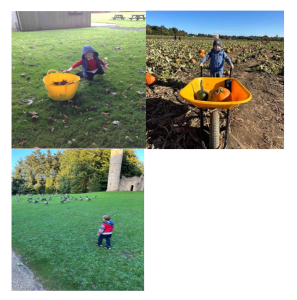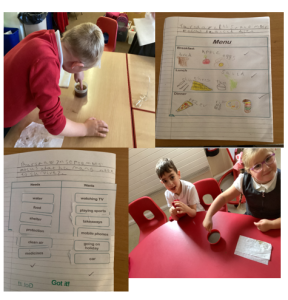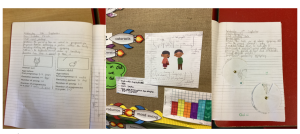Long Term Plan
Nursery have been learning about the changes of the seasons. The children compared their own local environment around their home to their school environment.
Understanding the world – Nursery

Reception class have explored the natural world around them by describing what they can see, hear and feel while outside. The children have been able to spot changes and are beginning to understand the effect of changing seasons on the natural world around them. While learning about our bodies, children have been able to name different parts of the body and their function.

Year 2 have been looking at what we need in order to survive. We have learned about the 5 different food groups and how they affect our body. We have discussed hygiene and why it is important to wash our hands to keep us healthy. During a science lesson we experimented with pepper and soap to explore how soap protects us from bacteria. We have had lots of fun doing this!

Year 3 have been exploring Nutrition and Skeletons. We have investigated the five key food groups and why they are essential for our health and growth. The children explored the labels found on different foods and how they can help us to make healthy choices about our diet. They learned about the different types of skeletons that animals have and how these have adapted to help the animal to move and survive in their environment. We explored the human skeleton, naming bones and explaining the function of the skeleton and enjoyed creating our own skeletons. We also explored the role of muscles and created our own models to explain how they work.

Year 4 have been learning about Animals including humans. During their science lessons the children have explored the simple functions of the basic parts of the digestive system in humans. The children really enjoyed learning about the different types of teeth humans have and investigated the effects of different liquids on teeth. To finish the unit the children constructed and interpreted a variety of food chains, identifying the producers, predators and prey.

Year 5 have been studying Animals, including humans where children learn how to describe the changes as humans develop to old age. This is the seventh time children have explored the topic of animals including humans and each previous year’s knowledge is built upon. We have looked at lifecycles in animals and humans, gestation periods, foetal development, puberty, investigating how children grow and finally what happens in the final part of our life cycle: old age and how to keep healthy in old age. We have been working on the skill of presenting findings and data which links to math’s.

Year 6 have been learning to identify and name parts of the human circulatory system. They can describe the function of the heart and they recognise the importance of diet, exercise, drugs and lifestyle on the way their bodies function. The children used their investigative skills to find out how blood and nutrients are transported around the human body.

Intent
Our curriculum is designed to:
- Science aims to develop fun, practical and engaging high quality teaching that inspires children.
- Provide children with an enabling environment and to encourage them the be confidence in exploring and discovering the world around them.
- To allow children to make links between the science investigations and experiments and real life.
- To allow children to see that there is no limits to their ambition and to explore different careers within science.
- To provide practical experiences that encourage curiosity and questioning.
- To help children secure and extend their scientific knowledge and vocabulary.
- recognise a child’s prior learning, abilities and experiences KWL grid at the start of every term to assess child’s current understanding and needs.
- provide stimulating and relevant first hand experiences First hand observations/investigations every unit.
- enable children to apply skills and knowledge in meaningful contexts Relates unit to everyday life e.g. healthy lifestyle, teeth health, impact science has in the world.
- develop interpersonal skills Introduction and use of correct vocabulary, collaborative work.
- build resilience, collaboration and perseverance As the children progress through KS2 children they are encouraged to plan their own investigative work.
- support resourceful and reflective learners Child led learning in some aspects form the KWL grid, homework is topic led, encouraging children to learn at home.
Many of the subject drivers for the topics are science led topics which enable the children to see science in meaningful contexts and provide a stimulating experience.
Each child is unique and we value and celebrate differences within school and the wider community. We pride ourselves in knowing and catering for a child’s individual needs from the academic to wellbeing needs.
Our enhancement opportunities both within school activities and in the curriculum are to ensure the children can become curious and enquiring learners, develop new interests, support a caring and respectful attitude towards others and become responsible for their own learning and attitudes. We also aim to raise aspirations and widen children’s ideas of what is on offer to them beyond the locality they live in for work, leisure and living. Interest and talents are valued and nurtured through strong family partnerships.
This is underpinned by high quality, rigorous teaching of basic skills and knowledge, concepts and values. We aspire for children to leave our Primary School as confident, respectful and tolerant individuals who know themselves well, have the courage to try new challenges and are inspired to aim high on their life path.
Implementation:
In developing our curriculum we have the following drivers at its heart:
| EYFS | Year 1 | Year 2 | Year 3 | Year 4 | Year 5 | Year 6 | |
| Understanding the world | Making sense of their physical world and their community
Increase of children’s personal experiences and meeting important people. Listening to a broad selection of stories. Enrich and widening of children’s vocabulary. |
||||||
| Working Scientifically | asking simple questions and recognising that they can be answered in different ways
observing closely, using simple equipment performing simple tests identifying and classifying using their observations and ideas to suggest answers to questions gathering and recording data to help in answering questions. |
asking relevant questions and using different types of scientific enquiries to answer them setting up simple practical enquiries, comparative and fair tests making systematic and careful observations and, where appropriate, taking accurate measurements using standard units, using a range of equipment, including thermometers and data loggers gathering, recording, classifying and presenting data in a variety of ways to help in answering questions recording findings using simple scientific language, drawings, labelled diagrams, keys, bar charts, and tables reporting on findings from enquiries, including oral and written explanations, displays or presentations of results and conclusions using results to draw simple conclusions, make predictions for new values, suggest improvements and raise further questions identifying differences, similarities or changes related to simple scientific ideas and processes
using straightforward scientific evidence to answer questions or to support their findings. |
planning different types of scientific enquiries to answer questions, including recognising and controlling variables where necessary taking measurements, using a range of scientific equipment, with increasing accuracy and precision, taking repeat readings when appropriate
recording data and results of increasing complexity using scientific diagrams and labels, classification keys, tables, scatter graphs, bar and line graphs using test results to make predictions to set up further comparative and fair tests reporting and presenting findings from enquiries, including conclusions, causal relationships and explanations of and a degree of trust in results, in oral and written forms such as displays and other presentations identifying scientific evidence that has been used to support or refute ideas or arguments. |
||||
| Plants | identify and name a variety of common wild and garden plants, including deciduous and evergreen trees
identify and describe the basic structure of a variety of common flowering plants, including trees |
observe and describe how seeds and bulbs grow into mature plants
find out and describe how plants need water, light and a suitable temperature to grow and stay healthy |
identify and describe the functions of different parts of flowering plants: roots, stem/trunk, leaves and flowers
explore the requirements of plants for life and growth (air, light, water, nutrients from soil, and room to grow) and how they vary from plant to plant investigate the way in which water is transported within plants explore the part that flowers play in the life cycle of flowering plants, including pollination, seed formation and seed dispersal |
||||
| Animals including humans | identify and name a variety of common animals including fish, amphibians, reptiles, birds and mammals
identify and name a variety of common animals that are carnivores, herbivores and omnivores describe and compare the structure of a variety of common animals (fish, amphibians, reptiles, birds and mammals including pets) identify, name, draw and label the basic parts of the human body and say which part of the body is associated with each sense |
notice that animals, including humans, have offspring which grow into adults
find out about and describe the basic needs of animals, including humans, for survival (water, food and air) describe the importance for humans of exercise, eating the right amounts of different types of food, and hygiene |
identify that animals, including humans, need the right types and amount of nutrition, and that they cannot make their own food; they get nutrition from what they eat
identify that humans and some other animals have skeletons and muscles for support, protection and movement |
describe the simple functions of the basic parts of the digestive system in humans
identify the different types of teeth in humans and their simple functions construct and interpret a variety of food chains, identifying producers, predators and prey |
describe the changes as humans develop to old age | identify and name the main parts of the human circulatory system, and describe the functions of the heart, blood vessels and blood
recognise the impact of diet, exercise, drugs and lifestyle on the way their bodies function describe the ways in which nutrients and water are transported within animals, including humans |
|
| Everyday materials | distinguish between an object and the material from which it is made
identify and name a variety of everyday materials, including wood, plastic, glass, metal, water, and rock describe the simple physical properties of a variety of everyday materials compare and group together a variety of everyday materials on the basis of their simple physical properties |
identify and compare the suitability of a variety of everyday materials, including wood, metal, plastic, glass, brick, rock, paper and cardboard for particular uses
find out how the shapes of solid objects made from some materials can be changed by squashing, bending, twisting and stretching |
|||||
| Seasons | observe changes across the 4 seasons
observe and describe weather associated with the seasons and how day length varies |
||||||
| Living things and their habitats | explore and compare the differences between things that are living, dead, and things that have never been alive
identify that most living things live in habitats to which they are suited and describe how different habitats provide for the basic needs of different kinds of animals and plants, and how they depend on each other identify and name a variety of plants and animals in their habitats, including microhabitats describe how animals obtain their food from plants and other animals, using the idea of a simple food chain, and identify and name different sources of food |
recognise that living things can be grouped in a variety of ways
explore and use classification keys to help group, identify and name a variety of living things in their local and wider environment recognise that environments can change and that this can sometimes pose dangers to living things |
describe the differences in the life cycles of a mammal, an amphibian, an insect and a bird
describe the life process of reproduction in some plants and animals |
describe how living things are classified into broad groups according to common observable characteristics and based on similarities and differences, including micro-organisms, plants and animals
give reasons for classifying plants and animals based on specific characteristics |
|||
| Rocks | compare and group together different kinds of rocks on the basis of their appearance and simple physical properties
describe in simple terms how fossils are formed when things that have lived are trapped within rock recognise that soils are made from rocks and organic matter |
||||||
| Light | recognise that they need light in order to see things and that dark is the absence of light
notice that light is reflected from surfaces recognise that light from the sun can be dangerous and that there are ways to protect their eyes recognise that shadows are formed when the light from a light source is blocked by an opaque object find patterns in the way that the size of shadows change |
recognise that light appears to travel in straight lines
use the idea that light travels in straight lines to explain that objects are seen because they give out or reflect light into the eye explain that we see things because light travels from light sources to our eyes or from light sources to objects and then to our eyes use the idea that light travels in straight lines to explain why shadows have the same shape as the objects that cast them |
|||||
| Forces and Magnets | compare how things move on different surfaces
notice that some forces need contact between 2 objects, but magnetic forces can act at a distance observe how magnets attract or repel each other and attract some materials and not others compare and group together a variety of everyday materials on the basis of whether they are attracted to a magnet, and identify some magnetic materials describe magnets as having 2 poles predict whether 2 magnets will attract or repel each other, depending on which poles are facing |
||||||
| State of Matter | compare and group materials together, according to whether they are solids, liquids or gases
observe that some materials change state when they are heated or cooled, and measure or research the temperature at which this happens in degrees Celsius (°C) identify the part played by evaporation and condensation in the water cycle and associate the rate of evaporation with temperature |
||||||
| Sound | identify how sounds are made, associating some of them with something vibrating
recognise that vibrations from sounds travel through a medium to the ear find patterns between the pitch of a sound and features of the object that produced it find patterns between the volume of a sound and the strength of the vibrations that produced it recognise that sounds get fainter as the distance from the sound source increases |
||||||
| Electricity | identify common appliances that run on electricity
construct a simple series electrical circuit, identifying and naming its basic parts, including cells, wires, bulbs, switches and buzzers identify whether or not a lamp will light in a simple series circuit, based on whether or not the lamp is part of a complete loop with a battery recognise that a switch opens and closes a circuit and associate this with whether or not a lamp lights in a simple series circuit recognise some common conductors and insulators, and associate metals with being good conductors |
associate the brightness of a lamp or the volume of a buzzer with the number and voltage of cells used in the circuit
compare and give reasons for variations in how components function, including the brightness of bulbs, the loudness of buzzers and the on/off position of switches use recognised symbols when representing a simple circuit in a diagram |
|||||
| Properties and changes of materials | compare and group together everyday materials on the basis of their properties, including their hardness, solubility, transparency, conductivity (electrical and thermal), and response to magnets
know that some materials will dissolve in liquid to form a solution, and describe how to recover a substance from a solution use knowledge of solids, liquids and gases to decide how mixtures might be separated, including through filtering, sieving and evaporating give reasons, based on evidence from comparative and fair tests, for the particular uses of everyday materials, including metals, wood and plastic demonstrate that dissolving, mixing and changes of state are reversible changes explain that some changes result in the formation of new materials, and that this kind of change is not usually reversible, including changes associated with burning and the action of acid on bicarbonate of soda |
||||||
| Earth and space | describe the movement of the Earth and other planets relative to the sun in the solar system
describe the movement of the moon relative to the Earth describe the sun, Earth and moon as approximately spherical bodies use the idea of the Earth’s rotation to explain day and night and the apparent movement of the sun across the sky |
||||||
| Forces | explain that unsupported objects fall towards the Earth because of the force of gravity acting between the Earth and the falling object
identify the effects of air resistance, water resistance and friction, that act between moving surfaces recognise that some mechanisms including levers, pulleys and gears allow a smaller force to have a greater effect |
||||||
| Evolution and inheritance | recognise that living things have changed over time and that fossils provide information about living things that inhabited the Earth millions of years ago
recognise that living things produce offspring of the same kind, but normally offspring vary and are not identical to their parents identify how animals and plants are adapted to suit their environment in different ways and that adaptation may lead to evolution |
||||||
Impact:
- Children enjoy and are enthusiastic about science.
- Children are confident to use and explain scientific vocabulary.
- Children can ask questions about their science learning and reflect on their knowledge.
- There is a clear progression of children’s work and teachers’ expectations.
- Children are becoming increasingly independent in science, and completing pupil lead investigations.
- Children complete pre-assessments (KWL) to ensure any misconceptions of a topic are addressed.
- Children complete post-assessment questions to assess children’s learning.
Medium Term Planning
Science MTP year 1
Science MTP year 2
Science MTP Year 3
Science MTP year 4
science MTP year 5
Science MTP year 6
Long Term Planning










